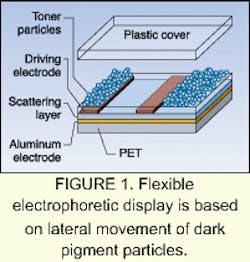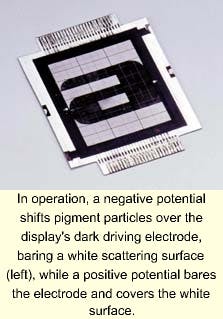Paperlike display uses in-plane electrophoresis
TOKYO - Engineers at Canon have developed a paperlike display in which electrophoresis is used for the writing mechanism (see Fig. 1). The term "paperlike" refers to a thin, flexible, reflective display in which the displayed pattern can be sustained without electrical input. The research effort attempts to combine the benefits of conventional displays (liquid-crystal displays, cathode-ray tubes) with those of paper products. Such displays have already been proposed and developed around the world (see Laser Focus World, January 2001, pp. 16 and 77), but this one is the first in which the pattern is changed by electrically controlling the in-plane distribution of the pigment particles on the foundation—a method called in-plane electrophoresis.
When the electric potential of the primary driving electrode is positive with respect to the secondary driving electrode, the pigment particles move to areas that do not have electrodes. The primary driving electrodes are colored black, so the entire display absorbs light and appears black.In order to make the display flexible, the foundation on the bottom is made of polyethylene terephthalate (PET; see Fig. 2). An aluminum secondary driving electrode and a white scattering layer are laid of top of this foundation. A primary driving electrode is positioned in a striped pattern and covered with a clear insulator. Finally, a clear plastic foundation is placed on top of everything, with a spacer in between. A clear insulating liquid is injected into the space. Black toner particles with positive charge are dispersed within this liquid. The thickness of the entire multilayered structure is about 300 µm.
Conversely, when the primary driving electrode takes on a negative value, the pigment particles move on top of the electrodes. The white scattering layer is then exposed, so the affected areas of the image appear light. Although the screen is in the white state, it does not look completely white because the top of the primary driving electrodes absorbs light. However, under experimental conditions, a white-to-black contrast of more than 8:1 has been seen. The driving voltage is 40 to 100 V. The response time varies from 30 to 15 ms depending on voltage.
The trial device can display images even when curved. The image, which is sustained after the current wires are removed following the initial voltage application, is stable even after being left for a week and is not affected by being bent or pressed.
The prototype device is made of 46 direct-driven matrix elements with electrical wires connected to each of the image elements. Development of a simple matrix-driven type of display is also under way. It is expected that by adding fine-control electrodes, and by adding obstacles that limit the movement of the pigment particles, the particles can eventually be controlled freely. A trial image element in this study has a size of 4 x 4 mm.2 Each image element is controlled by multiple driving electrodes that run horizontally and vertically across the surface.
The researchers believe that it is possible to build one image element per 120-µm electrode pitch, which would result in a resolution of about 200 dpi. By adjusting the driving voltage, gradated displays should also be feasible. Using cyan, magenta, and yellow pigment particles in a multilevel structure can make full-color paperlike displays. Canon does not expect serious commercialization efforts to commence until at least 2007; however, the company hopes to engage in market trials of a more-stable display as early as next year.
Courtesy O plus E magazine, Tokyo

